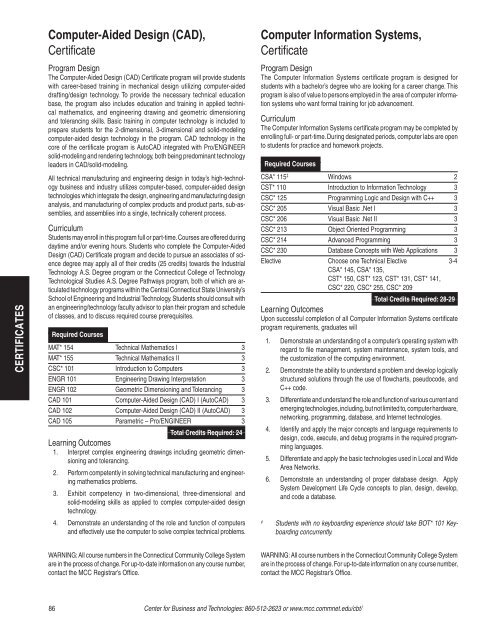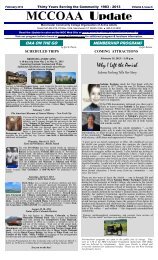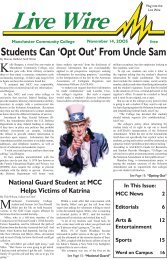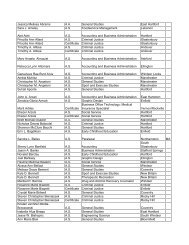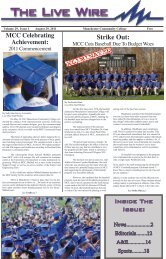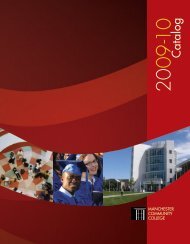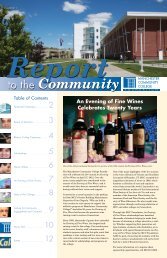Liberal Arts and Science - Manchester Community College ...
Liberal Arts and Science - Manchester Community College ...
Liberal Arts and Science - Manchester Community College ...
Create successful ePaper yourself
Turn your PDF publications into a flip-book with our unique Google optimized e-Paper software.
CERTIFICATES<br />
Computer-Aided Design (CAD),<br />
Certificate<br />
Program Design<br />
The Computer-Aided Design (CAD) Certificate program will provide students<br />
with career-based training in mechanical design utilizing computer-aided<br />
drafting/design technology. To provide the necessary technical education<br />
base, the program also includes education <strong>and</strong> training in applied technical<br />
mathematics, <strong>and</strong> engineering drawing <strong>and</strong> geometric dimensioning<br />
<strong>and</strong> tolerancing skills. Basic training in computer technology is included to<br />
prepare students for the 2-dimensional, 3-dimensional <strong>and</strong> solid-modeling<br />
computer-aided design technology in the program. CAD technology in the<br />
core of the certificate program is AutoCAD integrated with Pro/ENGINEER<br />
solid-modeling <strong>and</strong> rendering technology, both being predominant technology<br />
leaders in CAD/solid-modeling.<br />
All technical manufacturing <strong>and</strong> engineering design in today’s high-technology<br />
business <strong>and</strong> industry utilizes computer-based, computer-aided design<br />
technologies which integrate the design, engineering <strong>and</strong> manufacturing design<br />
analysis, <strong>and</strong> manufacturing of complex products <strong>and</strong> product parts, sub-assemblies,<br />
<strong>and</strong> assemblies into a single, technically coherent process.<br />
Curriculum<br />
Students may enroll in this program full or part-time. Courses are offered during<br />
daytime <strong>and</strong>/or evening hours. Students who complete the Computer-Aided<br />
Design (CAD) Certificate program <strong>and</strong> decide to pursue an associates of science<br />
degree may apply all of their credits (25 credits) towards the Industrial<br />
Technology A.S. Degree program or the Connecticut <strong>College</strong> of Technology<br />
Technological Studies A.S. Degree Pathways program, both of which are articulated<br />
technology programs within the Central Connecticut State University’s<br />
School of Engineering <strong>and</strong> Industrial Technology. Students should consult with<br />
an engineering/technology faculty advisor to plan their program <strong>and</strong> schedule<br />
of classes, <strong>and</strong> to discuss required course prerequisites.<br />
Required Courses<br />
MAT* 154 Technical Mathematics I 3<br />
MAT* 155 Technical Mathematics II 3<br />
CSC* 101 Introduction to Computers 3<br />
ENGR 101 Engineering Drawing Interpretation 3<br />
ENGR 102 Geometric Dimensioning <strong>and</strong> Tolerancing 3<br />
CAD 101 Computer-Aided Design (CAD) I (AutoCAD) 3<br />
CAD 102 Computer-Aided Design (CAD) II (AutoCAD) 3<br />
CAD 105 Parametric – Pro/ENGINEER 3<br />
Total Credits Required: 24<br />
Learning Outcomes<br />
1. Interpret complex engineering drawings including geometric dimensioning<br />
<strong>and</strong> tolerancing.<br />
86<br />
2. Perform competently in solving technical manufacturing <strong>and</strong> engineering<br />
mathematics problems.<br />
3. Exhibit competency in two-dimensional, three-dimensional <strong>and</strong><br />
solid-modeling skills as applied to complex computer-aided design<br />
technology.<br />
4. Demonstrate an underst<strong>and</strong>ing of the role <strong>and</strong> function of computers<br />
<strong>and</strong> effectively use the computer to solve complex technical problems.<br />
WARNING: All course numbers in the Connecticut <strong>Community</strong> <strong>College</strong> System<br />
are in the process of change. For up-to-date information on any course number,<br />
contact the MCC Registrar’s Office.<br />
Computer Information Systems,<br />
Certificate<br />
Program Design<br />
The Computer Information Systems certificate program is designed for<br />
students with a bachelor’s degree who are looking for a career change. This<br />
program is also of value to persons employed in the area of computer information<br />
systems who want formal training for job advancement.<br />
Curriculum<br />
The Computer Information Systems certificate program may be completed by<br />
enrolling full- or part-time. During designated periods, computer labs are open<br />
to students for practice <strong>and</strong> homework projects.<br />
Required Courses<br />
CSA* 115 ‡ Windows 2<br />
CST* 110 Introduction to Information Technology 3<br />
CSC* 125 Programming Logic <strong>and</strong> Design with C++ 3<br />
CSC* 205 Visual Basic .Net I 3<br />
CSC* 206 Visual Basic .Net II 3<br />
CSC* 213 Object Oriented Programming 3<br />
CSC* 214 Advanced Programming 3<br />
CSC* 230 Database Concepts with Web Applications 3<br />
Elective Choose one Technical Elective 3-4<br />
CSA* 145, CSA* 135,<br />
CST* 150, CST* 123, CST* 131, CST* 141,<br />
CSC* 220, CSC* 255, CSC* 209<br />
Total Credits Required: 28-29<br />
Learning Outcomes<br />
Upon successful completion of all Computer Information Systems certificate<br />
program requirements, graduates will<br />
1. Demonstrate an underst<strong>and</strong>ing of a computer’s operating system with<br />
regard to file management, system maintenance, system tools, <strong>and</strong><br />
the customization of the computing environment.<br />
2. Demonstrate the ability to underst<strong>and</strong> a problem <strong>and</strong> develop logically<br />
structured solutions through the use of flowcharts, pseudocode, <strong>and</strong><br />
C++ code.<br />
3. Differentiate <strong>and</strong> underst<strong>and</strong> the role <strong>and</strong> function of various current <strong>and</strong><br />
emerging technologies, including, but not limited to, computer hardware,<br />
networking, programming, database, <strong>and</strong> Internet technologies.<br />
4. Identify <strong>and</strong> apply the major concepts <strong>and</strong> language requirements to<br />
design, code, execute, <strong>and</strong> debug programs in the required programming<br />
languages.<br />
5. Differentiate <strong>and</strong> apply the basic technologies used in Local <strong>and</strong> Wide<br />
Area Networks.<br />
6. Demonstrate an underst<strong>and</strong>ing of proper database design. Apply<br />
System Development Life Cycle concepts to plan, design, develop,<br />
<strong>and</strong> code a database.<br />
‡ Students with no keyboarding experience should take BOT* 101 Key-<br />
boarding concurrently.<br />
WARNING: All course numbers in the Connecticut <strong>Community</strong> <strong>College</strong> System<br />
are in the process of change. For up-to-date information on any course number,<br />
contact the MCC Registrar’s Office.<br />
Center for Business <strong>and</strong> Technologies: 860-512-2623 or www.mcc.commnet.edu/cbt/


